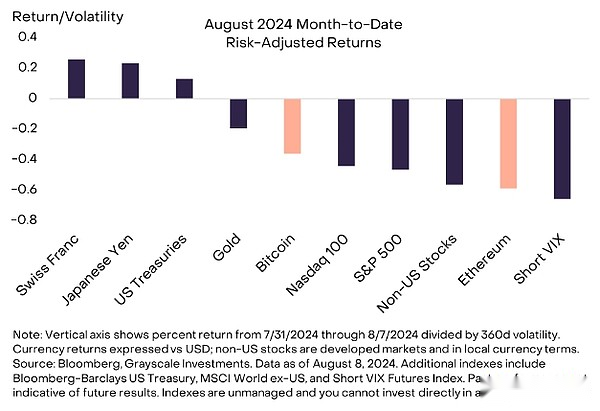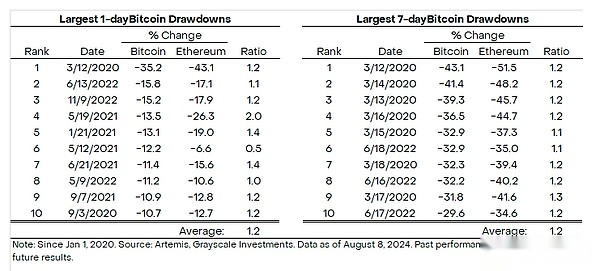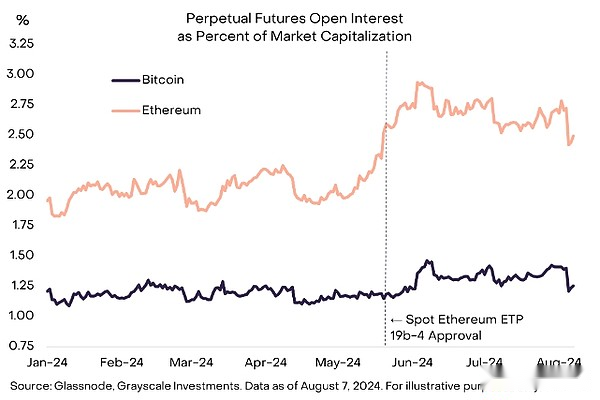
Source: Grayscale; Compilation: Baishui, bitchain vision
summary
-
Cryptocurrency valuations fell in early August amid concerns over the outlook for the U.S. economy and wider financial market volatility.Ethereum’s poor performance may be due to increased positions in the futures market and the sale of a few large holders.
-
If the U.S. economy continues to be on the road to a “soft landing”, Grayscale Research expects to rebound token valuations.
-
However, even in a weaker economic environment, Grayscale Research has reason to believe that the downside risk of prices may be more limited than in the past.
Crypto assets and the broader financial markets stabilized mid-week after a sharp decline from August 2 (Friday) to August 5 (Monday) (Figure 1).Although major token prices are usually less relevant to other asset classes, volatility in traditional markets may affect cryptocurrencies’ valuations.
Figure 1: Bitcoin and Ethereum fall in early August

The direct cause of the decline is the weaker-than-expected U.S. jobs report for July released on Friday, August 2.In particular, the report shows that the unemployment rate has risen as much as in previous recessions.[1] Concerns about a cyclical recession have led to weak cyclical assets such as stocks, while traditional safe-haven assets such as U.S. Treasury, Japanese yen and Swiss francs have performed strongly (Figure 2).Strategies for non-U.S. stocks and shorting volatility in U.S. stocks have performed particularly poorly.Bitcoin and Ethereum both declined; although Bitcoin performed relatively well after risk adjustments,Ethereum is not performing as well as other crypto assets and many traditional market segments, we will discuss it further below.Among the major crypto assets, Solana has performed significantly better than other crypto assets.
Figure 2: Ethereum performs poorly

Although Ethereum has higher volatility than Bitcoin, it has performed more significantly during its most recent decline than usual.For example, Chart 3 shows the largest percentage drop in Bitcoin price since 2020 and compares it to the decline in Ethereum price over the same period.In these events,Ethereum’s price usually falls by about 1.2 times the price of Bitcoin.The latest “cryptocurrency winter” (i.e., during bear markets) shows similar relative performance.[2] By contrast, as of August 2024, Ethereum’s price had fallen by about 1.8 times the price of Bitcoin, indicating that Ethereum is facing additional, unique downward pressure.
Figure 3: On average, Ethereum usually falls 1.2 times that of Bitcoin

One of the reasons for the relatively large decline in Ethereum prices seems to be the excessive long positions in perpetual futures.In May 2024, traders significantly increased their total positions in perpetual futures as the Securities and Exchange Commission (SEC) approved the issuer’s 19b-4 application for U.S. spot Ethereum Exchange Trading Products (ETP) (Figure 4), perhaps it is expected that prices will rise further after obtaining full regulatory approval; the approval was obtained in July 2024, and US spot Ethereum ETP began trading shortly afterwards.Subsequently, some long positions were liquidated in the recent decline, accelerating the price decline.On August 4, Ethereum’s price fell 7.6% in just three minutes, with the total clearing of perpetual futures on the day alone reaching $340 million.[3] Since the sell-off occurred during the overnight trading session in the United States and Binance’s spot price was significantly discounted compared to Coinbase [4], the liquidation seemed to be dominated by leveraged traders in Asia.[5]
Chart 4: Ethereum futures leverage increase in May 2024

Another factor that could lead to poor performance on Ethereum is the actual and expected sell-offs of a few large holders, including market maker Jump Crypto, venture capitalists Paradigm and Golem Network, a crypto protocol that has a large number of Ethereum treasury assets..[6] Although the exact amount of the sell-off cannot be determined, according to data from analytics platform Arkham Intelligence, Grayscale Research estimates that these entities hold a total of about $1.5 billion worth of Ethereum before they began to transfer their tokens (based on the Ethereum price at the time)[7]).The decline in the number of active validators and the rise in Ethereum staking reward rate also indicate a change in the supply of relatively sticky tokens, which may affect market sentiment.[8]
The broader financial markets have stabilized over the past week.Perhaps most notably, the VIX index, which measures implicit volatility in the U.S. stock market, closed down to 26% on Thursday after reaching an intraday high of more than 60% on Monday (Chart 5).Whether the market can continue to stabilize will depend on upcoming macroeconomic and corporate earnings data, as well as any policy response from the Federal Reserve or other central banks.On the economic data side, key upcoming reports include weekly unemployment benefits filing reports (released every Thursday), Consumer Price Index reports (released on August 14) and the next jobs report (released on September 6Published on Sunday).The Fed is likely to cut interest rates at its September 18 meeting, but the market is more concerned about policy paths thereafter.Policy makers may provide more guidance at the Jackson Hall workshop, which will be held August 22-24.
Figure 5: Market volatility declines in the past week

If the U.S. economy avoids recession and continues on the road to a “soft landing”, Grayscale Research expects to rebound token valuations and Bitcoin will retest its all-time highs later this year.However, even in a weaker economic environment, Grayscale Research has reason to believe that the downside risk of prices may be more limited than past declines.These include relatively stable net demand from new U.S. listed ETPs, insufficient credit provided by centralized financial institutions during the cycle [9], and relatively low returns on altcoins since the beginning of the year.Changes in the US political landscape around the crypto industry may also reduce the downside risk of valuations compared to past cycles.
Economic cycles are an inevitable feature of investing in almost all asset classes, and uncertainty in the macro outlook should be seen as short-term risks for crypto investors.Meanwhile, Grayscale Research believes thatPeople are almost intolerant of a severe recession and are expected to start printing money and spending when problems arise.Irregular monetary and fiscal policy practices are one of the reasons some investors choose to invest in Bitcoin; therefore, a period of economic weakness may strengthen Bitcoin’s long-term investment argument.
References
[1] Economists often refer to this statistical law as the “Sam Rule”.
[2] For example, both Bitcoin and Ethereum fell by the same magnitude during the peak to trough of the Bitcoin price in the previous cycle.During the “bear market” between March 2022 and October 2023, Ethereum fell 1.3 times that of Bitcoin.Source: Artemis, Grayscale Research.
[3] Source: Trading View, Coinglass.
[4] Source: Coinglass
[5] On-chain clearing may also be one of the reasons for the sharp decline in Ethereum prices.For example, lending platform Aave reported a $239 million liquidation on August 5.Source: Dune Analytics.Data as of August 8, 2024.For illustration purposes only.
[6] Source: The Defiant, CoinDesk, Arkham Intelligence data.
[7] The specific date is Paradigm on June 21, 2024, Golem on July 8, 2024, and Jump on July 24, 2024.
[8] Source: validatorqueue.com.
[9] In recent years, several centralized lending companies have gone bankrupt.Source: Blockworks.








